Oriental Hornet
Vespa orientalis
orientalis Linnaeus,
1771
click on thumbnails to enlarge the images
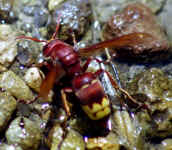
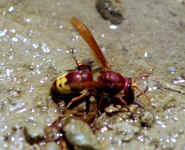
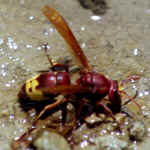
Photos: Dieter Kosmeier,
Zakynthos/Greek in '98
FERROELECTRIC-LIKE
PROPERTIES OF HORNET STRUCTURES OR CONSTRACTION. J.S.
Ishay and L.Litinetsky. Department of Physiology and Pharmacology, Sackler,
Faculty of Medicine, Tel - Aviv University, Ramat - Aviv,69978, Tel - Aviv,
Israel.
...listen to the hornets
here!
Various structures or constructions
of the Oriental Hornet Vespa orientalis ( Hymenoptera, Vespinae) such as the cuticle, the
spun silk and the comb cell walls discharge an electric current. In the dark, at a
temperature range of 5 - 33° C, this current increases with rise in the temperature and
decreases as the temperature drops. Between the ascending and descending "lines"
of the current, a broad hysteresis is formed.þ The created current may attain a level of
up to 700 nano Amperes (nA). Upon exposure to light of the hornets or its constructions,
the electric current diminishes within minutes to its minimal values, no hysteresis is
formed between the warming and cooling lines and the voltage increases. The event
described suggest that the structures or constructures in question contain polar materials
that undergo change in conformation and polarized, becoming a capacitor with layers of
opposite polarization. This explains why the voltage rises and the current decreases
during exposure to light, whereas in the dark (and at suitable temperature), the mentioned
materials revert to a state of spontaneous polarization and gradually release, as electric
current the charge that was picked up under illumination. The observed phenomena are
characteristic of materials that are semiconductors endowed with ferroelectric properties.
The influence of these properties on the gravity perception is discussed.
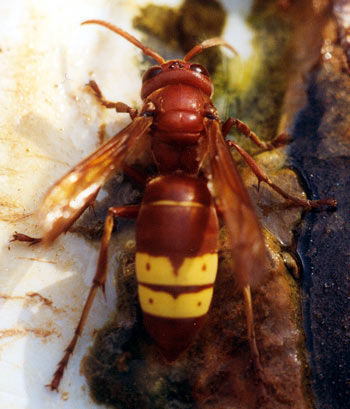
Photo:
Götz Lück, taken in Turkey
click on thumbnails to enlarge the images
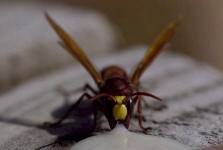
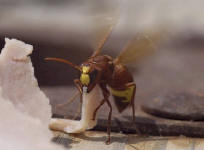
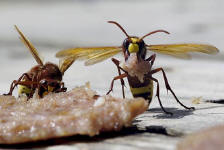
Photos: Kris Mercer, taken in
09/2002 in Mesa Chorio, Zypern
The first photo is a Oriental
Hornet drinking milk, the second shows a hornet trying to take flight with a large piece of ham. A case of biting off more than you can fly
with. The other is of hornets tucking into a raw hamburger.
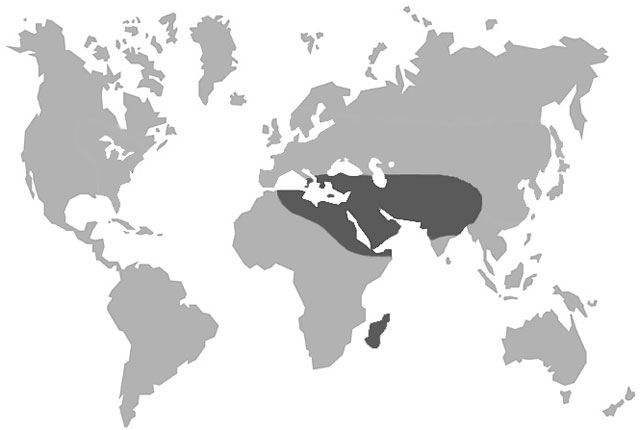
Distribution of Vespa orientalis
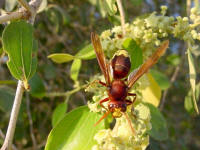
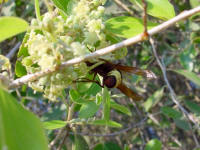
Photos: Holger Martz,
taken in
09/2001 in Tel Aviv / Raman Aviv; Israel
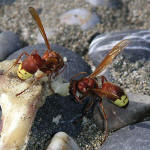
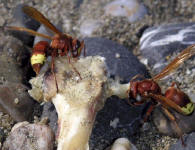
Photos:
Stephan Besche, taken in Turkey
THERMOELECTRIC
EFFECT IN HORNET SILK AND THERMOREGULATION IN HORNET'S NEST
Jacob S. Ishay and Vered Barenholz Paniry, Department of Physiology and Pharmacology,
Sackler Faculty of Medicine Tel Aviv University, Ramat Aviv 69978 Israel
The silk caps of the pupae of the
Oriental hornet (Vespa orientalis, Vespinae, Hymenoptera) were measured for spontaneous
electric current flow as a function of temperature. The measurements were made in the
dark, within the range of biological temperatures. Clear correlation was detected between
temperature rise and the increase in electric current forming in the silk. Thus at the
temperature associated with maximal current, namely, 27-30°C, the electric current
reached hundreds of nAmp whereas at 5°C the current was merely dozens of nAmp.
Interestingly, the temperature range associated with optimal currents is also identical to
the optimal temperature existant in the hornet nest and enabling proper development of the
colony. In the Discussion section, an attempt is made to explain the thermoelectric
mechanism in pupal silk and its contribution, as thermometer and thermostat, to
thermoregulation of the individual pupae, each of which is an independent thermal unit.
The thermoregulation here is compared with the mode of action of heat pipes in
industry.
Oriental
Hornet and Cataglyphis (Ants)
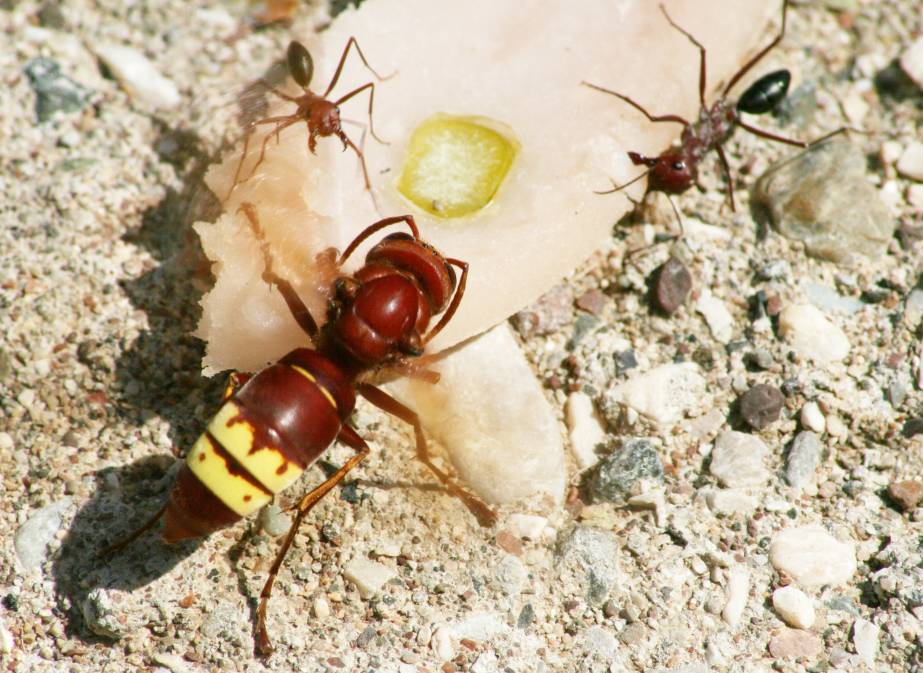
Photos: Oliver Schätzlein, taken in Turkey
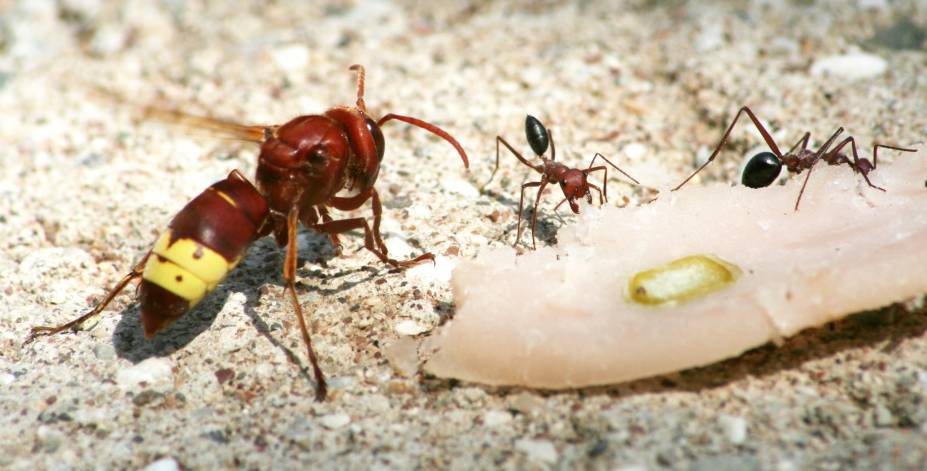
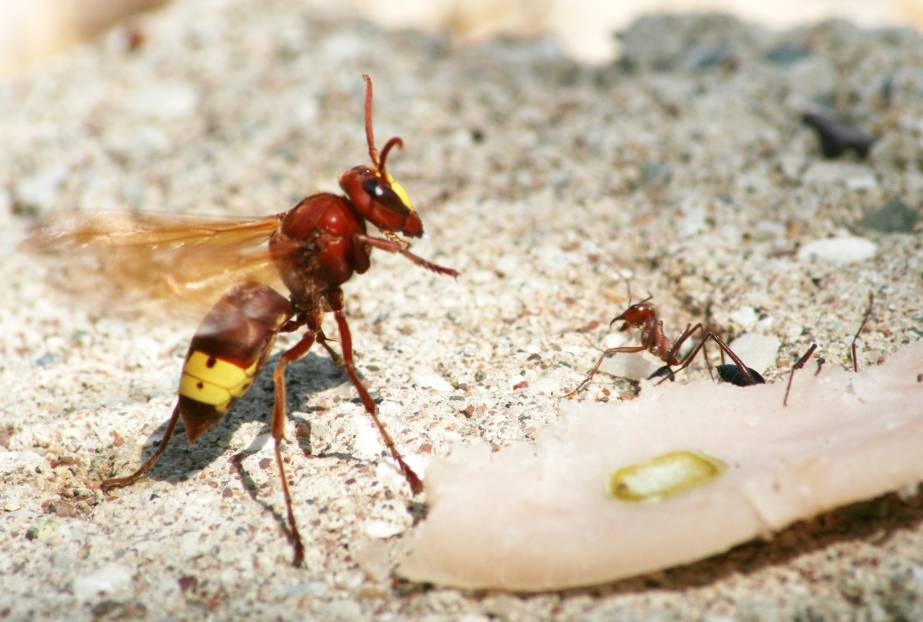
Recent
publications of Professor Jacob Ishay (E-Mail: physio7@post.tau.ac.il
):
-
E. Rosenzweig, E. Horodiceanu, J.S.
Ishay. Regeneration of guinea pig facial nerve: The effect of
hypergravity. 17 (6/7): 129-137, 1996. -
J.S. Ishay, M. Shmuelson.
Thermoelectric properties of the hornet comb: A device for producing
transforming and storing electrical energy for the entire colony.
Physiol. Chem. & Physics and Medical NMR. 28: 41-54, 1996. -
J.S. Ishay, A. Landsberg, S. Pelah.
Micromorphology of the fibers behind the frons plate and its
adjacent regions in the Oriental hornet (Hymenoptera, Vespinae).
Scanning Microscopy 10(1): 187-208, 1996. -
J.S. Ishay, L. Litinetsky.
Thermoelectric current in hornet cuticle: Morphological and
electrical changes induced by temperature and light. Physiol. Chem.
& Physics and Medical NMR 28: 55-67, 1996. -
O. Goldstein, L. Litinetsky, J.S. Ishay.
Extraretinal photoreception in hornets. Phys. Chem. & Physics
and Medical NMR. 28: 129-136, 1996. -
O. Goldstein, J.S. Ishay. Morphology of
a Putative New Peripheral Photoreceptor in Social Wasps. Physiol.
Chem. Phys. & Medical NMR. 28(4): 255-266, 1996. -
J.S. Ishay, O. Goldstein, E.
Rosenzweig, D. Kalicharan, W.L. Jongebloed. Hornet yellow cuticle
Microstructure: A photovoltaic system. Phys. Chem. Phys. &
Medical NMR, 29:71-93, 1997.
-
J.S. Ishay, V. Barenholz-Paniry, A.
Bitler. On hornet silk as a photodetector: considerations of current,
voltage and resistance. Phys. Chem. & Phys. and Medical NMR,
29:95-108, 1997.
Guestbook
Guestbook 1998 - 2007
next
page:Vespa mandarinia

Hymenoptera>Vespoidea>Vespidae>Vespa
crabro>Hornisse>Hornet>Frelon>Hoornaar>Vespa
grande>Abejorro>Calabrone
Hymenoptera>Vespoidea>Vespidae>Vespa
crabro>Hornisse>Hornet>Frelon>Hoornaar>Vespa grande>Abejorro>Calabrone
Webmaster:
Dieter Kosmeier
Hymenoptera>Vespoidea>Vespidae>Vespa
crabro>Hornisse>Hornet>Frelon>Hoornaar>Vespa grande>Abejorro>Calabrone
Hymenoptera>Vespoidea>Vespidae>Vespa
crabro>Hornisse>Hornet>Frelon>Hoornaar>Vespa grande>Abejorro>Calabrone

www.vespa-crabro.de
|